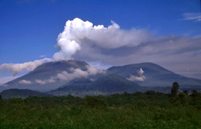
Media Monitor has never dedicated anything to anyone before, but this essay is written unreservedly in honour of Dieudonné Wafula and his small team of Goma volcanologists
Wafula, 48, a physicist turned volcanologist, correctly predicted the January 17 eruption of Mt Nyiragongo (Democratic Republic of the Congo) as early as the eighth of the month. Despite repeated attempts to make people listen his warnings went unheeded. To add injury to this insult, Wafula has never been paid for his work on the volcano (which began in the 1970s). He has, in the intervening years, braved murderous gangs of rebel fighters to monitor his frequently vandalised equipment, and when the eruption happened just as he had foretold, his lodgings in Goma, together with all his possessions were destroyed.
According to reports, Wafula began issuing general warnings as much as three months before the volcano erupted. He then refined them two weeks, and finally two days, before the lava rushed through downtown Goma. Wafula, evidently a resilient and unembittered man, told reporters "It would help if I got a little more support".
Wafula is reported to have told leaders of the Congolese Rally for Democracy (which controls Goma) "several months" before the eruption that they needed a contingency plan. The response was to bring in some Japanese consultants – who discounted his predictions. Some weeks later he wrote a piece for a monthly Goma newspaper, warning residents that they could expect an eruption. His prediction was based on the observation that there was 10 times more lava in Nyiragongo’s crater than there had been in 1977, when the last major eruption occurred.
Other press reports highlight the warnings Wafula gave to the BBC World Service, namely that the build-up of lava required "scientific follow-up immediately to prevent a disagreeable surprise". A disagreeable surprise. No-one could accuse Wafula of scaremongering. But once again nothing was done. The United Nations finally refused him the £200 he needed for an expedition to the crater – an act of parsimony that journalist James Astill, writing from Goma on January 23, credits with saving Wafula’s life.
Kofi Annan’s Special Envoy to the Goma disaster area, the aptly named Ross Mountain, told reporters that the UN "will use research by Wafula and other volcano experts in determining how to help the victims". But when it mattered and could have made more of a difference, did not consult Wafula at all after it refused to let him pass go and collect his £200. Instead it flew in eminent French volcanologist Jacques Durieux. Wafula had already emailed Durieux on January 14 about the imminent danger of an eruption.
One senses a certain embarrassment in Durieux’s quotes to crowds of waiting journalists in Goma. "You should really be asking Professor Wafula questions about this volcano" he is quoted as saying. "He’s the one who has been studying it, and forecast the eruption. He can give you the answers – I can’t." In fact, what he did do was probably very much more valuable; he affirmed both Wafula’s earlier work, and his conclusion that the eruption was over – thus giving him the credibility that, alas, prophets often lack in their own lands. Durieux left saying "Wafula has done a beautiful job with limited equipment". You can tell that volcanologists soon acquire a pervasive tendency to careful, moderate expression.
Daily Telegraph Journalist Tim Butcher flew with Wafula over the mountain a few days after the eruption – a flight paid for by the UN for "its own experts" – presumably Jacques Durieux. In between the jargon about "splatter-bombs and tremor amplitudes", Butcher reported Wafula as saying "It’s exactly what we thought… There was no explosive eruption, but a series of flank fractures from which the lava escaped. Butcher concludes: "Perhaps in future they could save their money [for the helicopter] and pay better attention to Mr Wafula’s reports".
Well, that would be something. But there’s a lot more to it, alas, than just one agency - even one as influential as the UN - pricking up its ears. Forecasting natural disasters is complex enough scientifically; but those difficulties pale beside the sociological complexities of turning a scientific warning into useful action.
Last year the Society, in advising the UK Government about the way it used scientific advice, pointed out that scientists (who are usually on transmit in any case) were not much use at all unless someone in Government had their mental receivers on the right wavelength. Governments need not only good advisers, but good receivers of advice – insider folk who can understand (and convey to ministers) the significance of what they hear.
In disaster zones, as well as scientists and government officials (between whom communication can be bad enough) you also have the aid agencies, various uniformed forces of civil defence, and the public. They all have different needs and capabilities, but none understands the other, and they all speak different languages. Turning a forecast into useful action in these circumstances does not happen naturally or spontaneously. These folk all need to know each other. Each group needs to understand the limits of what the other can tell them, and of what they in turn can do in response. And then – as Wafula told the powers that be in Goma – they must all agree a contingency plan, and communicate it to the populace so that it knows what to do when the worst happens. None of this was available to the sorry but resilient residents of Goma.
But a lone voice crying in the wilderness is at least a beginning. Perhaps now Dieudonné Wafula will get some new equipment. Perhaps Goma’s politicians will implement an action plan. Perhaps they might even pay him.
[Los Angeles Times/ latimes.com 22 January 2002; The Scotsman 23 January 2002; Daily Telegraph 23 January 2002 p16]